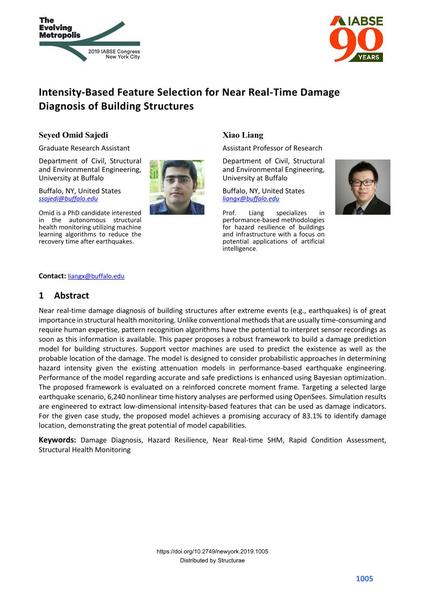Intensity-Based Feature Selection for Near Real-Time Damage Diagnosis of Building Structures

|
|
|||||||||||
Bibliografische Angaben
| Autor(en): |
Seyed Omid Sajedi
(Department of Civil, Structural and Environmental Engineering, University at Buffalo)
Xiao Liang (Department of Civil, Structural and Environmental Engineering, University at Buffalo) |
||||
|---|---|---|---|---|---|
| Medium: | Tagungsbeitrag | ||||
| Sprache(n): | Englisch | ||||
| Tagung: | IABSE Congress: The Evolving Metropolis, New York, NY, USA, 4-6 September 2019 | ||||
| Veröffentlicht in: | The Evolving Metropolis | ||||
|
|||||
| Seite(n): | 1005-1010 | ||||
| Anzahl der Seiten (im PDF): | 6 | ||||
| DOI: | 10.2749/newyork.2019.1005 | ||||
| Abstrakt: |
Near real-time damage diagnosis of building structures after extreme events (e.g., earthquakes) is of great importance in structural health monitoring. Unlike conventional methods that are usually time-consuming and require human expertise, pattern recognition algorithms have the potential to interpret sensor recordings as soon as this information is available. This paper proposes a robust framework to build a damage prediction model for building structures. Support vector machines are used to predict the existence as well as the probable location of the damage. The model is designed to consider probabilistic approaches in determining hazard intensity given the existing attenuation models in performance-based earthquake engineering. Performance of the model regarding accurate and safe predictions is enhanced using Bayesian optimization. The proposed framework is evaluated on a reinforced concrete moment frame. Targeting a selected large earthquake scenario, 6,240 nonlinear time history analyses are performed using OpenSees. Simulation results are engineered to extract low-dimensional intensity-based features that can be used as damage indicators. For the given case study, the proposed model achieves a promising accuracy of 83.1% to identify damage location, demonstrating the great potential of model capabilities. |
||||
